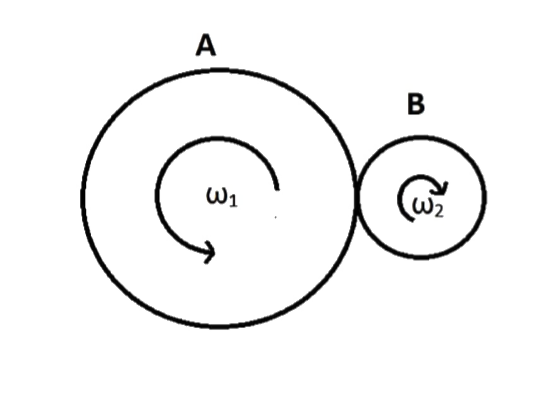Two coaxial discs, having moments of inertie I1 and I12 are rotating with respective angular volecities ω1 and ω12, about their common axis.They are brought in contact with each other and thereafter they rotate with a common angular volecity.If Ef and Ei are the final and initial total energies, then (Ef−E1) is:
−I1ω2124
−I1ω2112
38I1ω21
16I1ω21
The correct Answer is:A
From conservation of Angular momentum about the axis:
Li = Lf
⇒I1ω1+I12×ω12=(I1+I12)ωf⇒ωf=54I1ω132I1=56ω1
∴Ef−Ei=12(I1+I12)ω2f−[12I1ω21+12(I12)(ω12)2]=12×3I12(56ω1)2−916I1ω21=I1ω2124
Topper's Solved these Questions
- JEE MAIN REVISION TEST -14 BOOK - VMC MODULES ENGLISHCHAPTER - JEE MAIN REVISION TEST -14 EXERCISE - PHYSICS (SECTON 2)
5 Videos
- JEE MAIN REVISION TEST - 7|JEE - 2020BOOK - VMC MODULES ENGLISHCHAPTER - JEE MAIN REVISION TEST - 7|JEE - 2020EXERCISE - Physics (Section -2) (Numerical Value Type)
5 Videos
- JEE MAIN REVISION TEST -17 (2020)BOOK - VMC MODULES ENGLISHCHAPTER - JEE MAIN REVISION TEST -17 (2020)EXERCISE - PHYSICS
25 Videos
Similar Questions
Two uniform circular rough disc of moment of inertia I1 and I12 are rotating with angular velocity ω1 and ω12 respectively in same direction. Now one disc is placed the other disc co-axially. The change in kinetic energy of the system is :
View SolutionTwo bodies with moment of inertia l1 and l2 (l1>l2) have equal angular momentum. If E1 and E2 are the rotational kinetic energies, then
View Solution
Knowledge Check
Two discs of moments of inertia I1 and I2 about their respective axes , rotating with angular frequencies ω1 and ω2 respectively, are brought into contact face to face with their axes of rotation coincident. The angular frequency of the composite disc will be
Aa. I1ω1+I1ω2I1+I2Bb. I2ω1+I1ω2I1+I2Cc. I1ω1−I2ω2I1−I2Dd. I2ω1−I1ω2I1−I2Two discs of moments of inertia I1 and I2 about their respective axes (normal to the disc and passing through the centre), and rotating with angular speed ω1 and ω2 are brought into contact face to face with their axes of rotation coincident. What is the loss in kinetic energy of the system in the process?
AI1I2(ω1−ω2)22(I1+I2)BI1I2(ω1−ω2)22(I1+I2)CI1I2(ω1+ω2)2I1−I2DI1I2(ω1+ω2)22(I1−I2)
Two discs of moment of inertia I1 and I2 and angular speeds ω1 and ω2 are rotating along the collinear axes passing through their center of mass and perpendicular to their plane. If the two are made to rotate combindly along the same axis the rotational K.E. of system will be
View SolutionTwo discs A and B are in contact and rotating with angular velocity with angular velocities ω1andω2 respectively as shown. If there is no slipping between the discs, then

View SolutionTwo discs of moments of inertia I1andI2 about their respective axes (normal to the disc and passing through the centre), and rotating with angular speed ω1andω2 are brought into contact face to face with their axes of rotation coincident . What is the angular speed of the two-disc system ?
View SolutionTwo disc having moment of inertias I1 & I2 and angle velocities ω1 & ω2 are placed coaxially find total kinetic energy when they rotates with same angular velocity I1=0.10Kgm2 I2=0.20Kgm2 ω1=10radsec ω2=5radsec
View SolutionTwo discs of same moment of inertia rotating about their regular axis passing through centre and perpendicular to the plane of disc with angular velocities ω1 and ω2. They are brought into contact face to face coinciding the axis of rotation. The expression for loss of energy during this process is
View SolutionTwo discs of same moment of inertia rotating their regular axis passing through centre and perpendicular to the plane of disc with angular velocities ω1 and ω2. They are brought into contact face to the face coinciding the axis of rotation. The expression for loss of enregy during this process is :
View Solution
